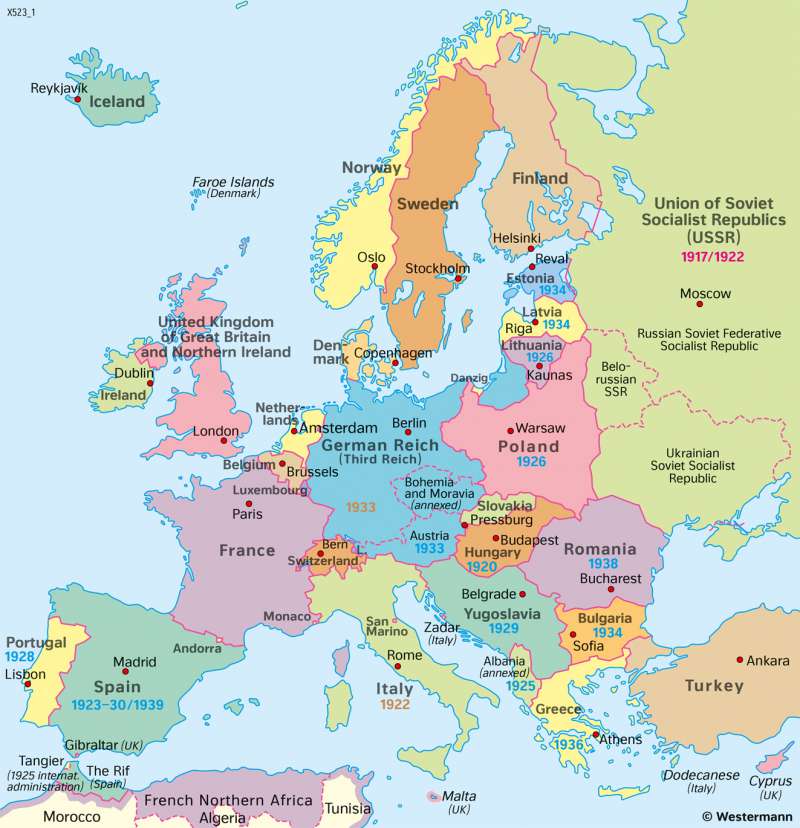Europe - Countries 1939 (before Word War Two)
Countries since 1900
978-3-14-100890-6 | Page 62 | Ill. 3

Overview
Already on the eve of World War II, the political map of Europe had changed again in contrast to the political reorganisation of the continent after 1918. In the area of tension between National Socialist Germany and the Soviet Union lay the states of the Baltic and the eastern part of Central Europe.Territorial border shifts and annexations of entire nation states were only the harbinger of changes of even greater magnitude that were to come over the continent in the five years of war that followed.
The map shows Europe before the conclusion of the non-aggression pact between Germany and the Soviet Union (Hitler-Stalin Pact), which provided for a division of Eastern Europe into spheres of influence. Belarus and Ukraine, which had declared themselves independent in the course of the Russian Revolution, had fallen partly to Russia and partly to Poland after the Polish-Soviet War of 1920.
Rise of totalitarmism
A characteristic feature of political development in interwar Europe was the collapse of numerous young democracies, especially in Southern, Central and Eastern Europe, and their replacement by authoritarian, fascist or - in the case of Germany - totalitarian regimes. The many causes of this phenomenon included social disparities, aggressive nationalism, domestic power and distribution struggles, and the world economic crisis (from 1929).
Weakening democracies
All over Europe, the new democracies that had been set in motion after the First World War, mostly flawed and half-hearted, were in retreat. In Italy, Benito Mussolini had begun his "March on Rome" in 1922 under the promise of national renewal, forcing the king to allow the fascists into government. In Spain, a military dictatorship was established a year later with the king's approval. In 1926, Marshal Józef Piłsudski carried out a coup d'état in Poland that made him de facto autocrat, despite the formal retention of the constitution and parliament. Two years later, a military coup in Portugal eliminated the parliamentary system. In 1929, Alexander I established a "royal dictatorship" in Yugoslavia; the parliament was dissolved, and the constitution abolished. In 1934, authoritarian presidential regimes were established in Estonia and Latvia following coups d'état. In the same year, Tsar Boris III of Bulgaria banned all political parties in his country. In 1936, Joannis Metaxas established a dictatorship in Greece by means of a coup d'état. In 1938, the arbitrary rule of Charles II of Romania also resulted in tyranny. In 1939, the dictatorial General Franco, with massive German support, seised power in Spain after a three-year civil war and sealed the end of the Second Republic (from 1931).
German policy of expansion
Germany had been ruled by the National Socialists since 1933. After changing the governmental power in their favour (“Machtergreifung†(seizure of power), “Gleichschaltung†(co-ordination)), they invaded the demilitarised Rhineland in 1936 despite the Olympic Games in their own country (Berlin, Garmisch-Partenkirchen). The "Anschluss" of Austria followed in March 1938 and in September 1938, at the Munich Conference, Great Britain and France gave in to Hitler-Germany’s blackmailing threats for the last time, whereupon Hitler was given a free hand in the occupation and annexation of the Sudetenland. With the occupation of the rest of Czechoslovakia in March 1939, the last supporters of an appeasement regarding Nazi Germany were aware of Hitler's true intentions - the political fronts then hardened and the everything pointed to war in Europe.




